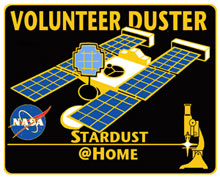One way of making this task easier came through automation and computer technology. “We realized that we had an automated microscope developed for a different purpose,” says Westphal. “We used it to take images of the aerogel in the collector and developed a virtual microscope that runs on web browsers. It’s much more comfortable to look at a picture on a screen than peer down a microscope for hours and hours.”

However, even with the help of the automated microscope and the 65 scientists on the Stardust team, Westphal and his colleagues realized that there was still no way they could search for the stardust themselves. So they recruited help. They started a project called Stardust@home, that was inspired by the success of SETI@home, a distributed computing project that uses volunteers’ computers to search for possible radio signals from extraterrestrial intelligence. While SETI@home uses the power of its volunteers’ computers, Stardust@home uses their brains and eyes. Westphal and collaborators discovered that interested non-scientists could easily learn how to recognize stardust and comet debris tracks in aerogel.
“Stardust@Home was one of the first citizen science projects and has inspired others,” notes Westphal. “We have had over 30,000 volunteers participate in the project since its inception. This is not just busywork — we couldn’t do the science without the dedication and commitment of our citizen scientists. They call themselves ‘Dusters,’ and they represent people from all walks of life, including teachers and their students. The person who discovered our first interstellar dust candidate is a retired carpenter from Ontario, Canada.”
